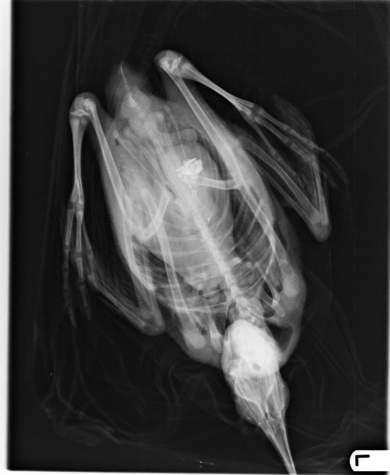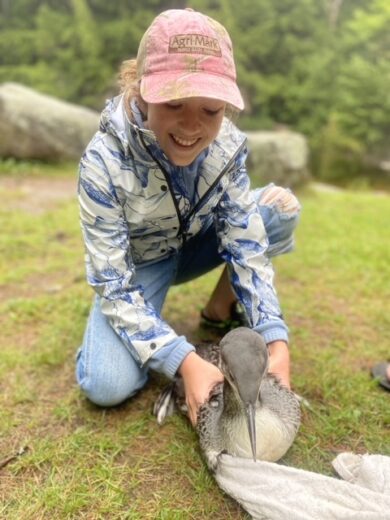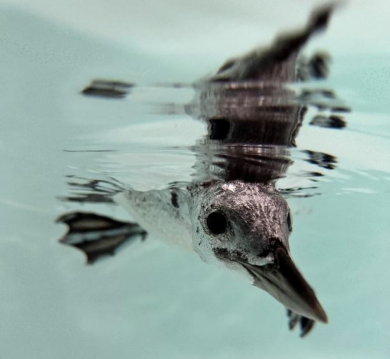The Harvey’s Lake loon chick in the rehabilitation swimming pool at Center for Wildlife, York, Maine, 8/10
This past summer VCE was involved in two very different loon chick rescues with very different outcomes. Although these ordeals did not have a lot in common, they each had dedicated and caring volunteers, willing to use their time and resources to help these birds.
Part 1: Harvey’s Lake Chick
On the gray sand of Harvey’s Lake beach in Barnet, VT, only a few steps from the water’s edge, sat a loon chick with its downy gray feathers and straight, pointed beak.
This chick had hatched around June 19, but a month later was spotted wandering by itself away from its parents. On Friday, July 28, Loon Conservation Project volunteer Jan Parsons found the bird in a parking lot near the swimming beach of Harvey’s Lake, a quarter mile away from the shoreline.
After keeping the loon in her bathtub for the afternoon, Jan brought it to the Vermont Institute of Natural Science (VINS) in Quechee, VT. Staff members Bren Lundborg and Grae O’Toole utilized their new waterbird pool to house and monitor the chick. Bren’s initial assessment reported that the bird appeared thin and lethargic, with no visible injuries. The loon was attempting to bite its rescuers in self-defense but lacked energy.
 An X-ray on Monday revealed a sinker and hook inside the chick, and its lead levels had tripled over the weekend. Once lead is swallowed and in a loon’s gizzard, it dissolves into their bloodstream, leading to lead poisoning. Affected loons can’t fly, swim in uneven circles, and experience tremors. By the time such symptoms of severe lead poisoning appear, it cannot be cured and the bird typically dies in about two weeks.
An X-ray on Monday revealed a sinker and hook inside the chick, and its lead levels had tripled over the weekend. Once lead is swallowed and in a loon’s gizzard, it dissolves into their bloodstream, leading to lead poisoning. Affected loons can’t fly, swim in uneven circles, and experience tremors. By the time such symptoms of severe lead poisoning appear, it cannot be cured and the bird typically dies in about two weeks.
Despite the high possibility that this loon chick wouldn’t survive, every effort was made to save the bird’s life. The chick was transferred to the Center for Wildlife in York, ME, where it was put under anesthesia and its gizzard was lavaged. It took two attempts over two days to wash the lead sinker out, after which the chick underwent a treatment for lead poisoning called chelation, using a medicine that binds to lead and flushes it out through urine. This treatment only works if the lead was recently ingested. This was also the first time that this procedure was performed on a Vermont loon. In most cases, it’s too late for this lead poisoning treatment by the time it’s clear that the bird is in trouble—displaying beaching behavior like this chick when it was found.
But the chick appeared to be on the mend, so it was transferred once more to the Biodiversity Research Institute (BRI) in Portland, ME. BRI took custody of the bird and continued to care for it, preparing for it to be released in Massachusetts. After it arrived in western MA, the chick seemed to be doing well, then passed away suddenly.
While this is a sad story, it’s not a rare one. Every year, lead tackle and discarded monofilament lines are responsible for nearly 50% of loon deaths in Vermont. This summer, VCE began spearheading an effort to reduce the amount of lead in people’s tackle boxes and clean up discarded fishing gear. To read more about the program and learn what you can do to help, visit our Loons and Lead Tackle page.
Part 2: Ricker Pond Chick

Loon chick being released back onto Ricker Pond by Nora. © Eloise Girard
In mid-August, a loon chick was sighted over the dam downstream from Ricker Pond in Groton, VT. After searching the area, VCE’s Loon Conservation Project Biologist Eric Hanson, Seasonal Loon Biologist Eloise Girard, and 13-year-old volunteer Nora found the chick on the bank next to the fast-flowing stream. The chick was around nine weeks old, so its parents were still around to care for it. Hanson determined it should be released back on the pond, as it was old enough to feed itself, and Nora did the honors.
A week later, the same incident occurred, and whoever reported the chick carried it back to the pond. Hanson drove there to investigate and found the bird in a weakened state, trying to feed near the shore. Though he didn’t think it had a high chance of survival, loon volunteer Jan Parson transported the chick to VINS, where they used their small waterbird pool to rehabilitate the bird over the next few weeks.
The chick was at least two to three pounds underweight. VINS had live bait delivered by BRI, which helped the bird to start eating and gaining weight. Its feathers were also badly neglected and no longer waterproof, but as it got stronger, the bird learned to preen and its feathers were restored. Through the care of BRI and VINS, the chick was able to make a full recovery.
At that point, the chick was transferred to BRI on September 12, who released it onto Buckley-Dunton Pond in western Massachusetts where it could be monitored almost daily. It fledged and flew off by September 28.
Then on October 19, BRI Loon Program Director Lucas Savoy, reported that their seasonal staff sighted the Ricker Pond chick on Stockbridge Bowl, in Stockbridge, MA, a lake approximately 9 miles west of its release lake. The chick appeared to be healthy and thriving.
Even though the loon chick’s chances of survival were slim, this story shows that all of the effort put into rescuing and rehabilitating the chick was worth it. Thank you to everyone who played a role in this success story!
To read more about the Loon Conservation Project, visit the project page.

